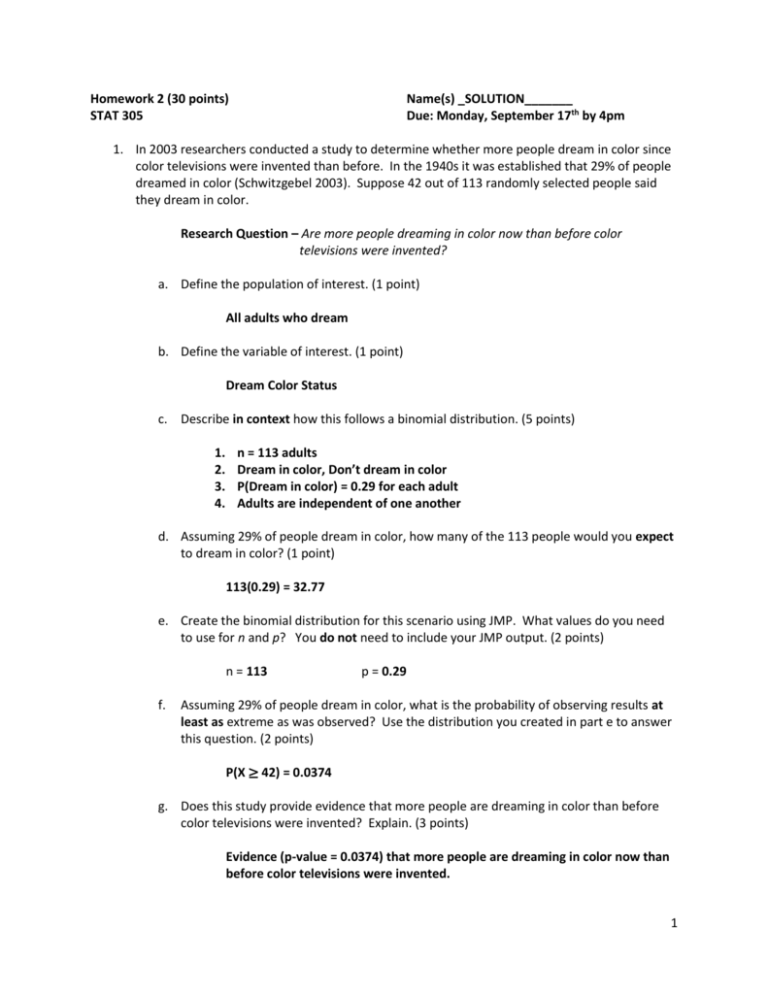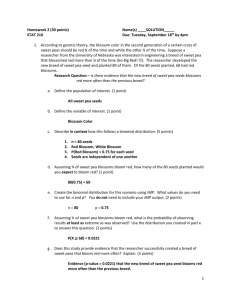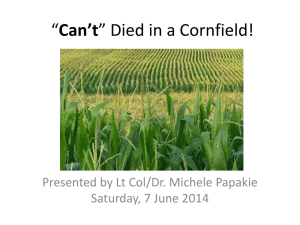Homework 2 (30 points) Name(s) _SOLUTION_______ STAT 305
advertisement

Homework 2 (30 points) STAT 305 Name(s) _SOLUTION_______ Due: Monday, September 17th by 4pm 1. In 2003 researchers conducted a study to determine whether more people dream in color since color televisions were invented than before. In the 1940s it was established that 29% of people dreamed in color (Schwitzgebel 2003). Suppose 42 out of 113 randomly selected people said they dream in color. Research Question – Are more people dreaming in color now than before color televisions were invented? a. Define the population of interest. (1 point) All adults who dream b. Define the variable of interest. (1 point) Dream Color Status c. Describe in context how this follows a binomial distribution. (5 points) 1. 2. 3. 4. n = 113 adults Dream in color, Don’t dream in color P(Dream in color) = 0.29 for each adult Adults are independent of one another d. Assuming 29% of people dream in color, how many of the 113 people would you expect to dream in color? (1 point) 113(0.29) = 32.77 e. Create the binomial distribution for this scenario using JMP. What values do you need to use for n and p? You do not need to include your JMP output. (2 points) n = 113 f. p = 0.29 Assuming 29% of people dream in color, what is the probability of observing results at least as extreme as was observed? Use the distribution you created in part e to answer this question. (2 points) P(X ≥ 42) = 0.0374 g. Does this study provide evidence that more people are dreaming in color than before color televisions were invented? Explain. (3 points) Evidence (p-value = 0.0374) that more people are dreaming in color now than before color televisions were invented. 1 2. According to genetic theory, the blossom color in the second generation of a certain cross of sweet peas should be red ¾ of the time and white the other ¼ of the time. Suppose a researcher from the University of Nebraska was interested in engineering a breed of sweet pea that blossomed red more than ¾ of the time (Go Big Red! ). The researcher developed the new breed of sweet pea seed and planted 80 of them. Of the 80 seeds planted, 66 had red blossoms. Research Question – Is there evidence that the new breed of sweet pea seeds blossoms red more often than the previous breed? a. Define the population of interest. (1 point) All sweet pea seeds b. Define the variable of interest. (1 point) Blossom color c. Describe in context how this follows a binomial distribution. (5 points) 1. 2. 3. 4. n = 80 seeds Red blossom, White blossom P(Red blossom) = 0.75 for each seed Seeds are independent of one another d. Assuming ¾ of sweet pea blossoms bloom red, how many of the 80 seeds planted would you expect to bloom red? (1 point) 80(0.75) = 60 e. Create the binomial distribution for this scenario using JMP. What values do you need to use for n and p? You do not need to include your JMP output. (2 points) n = 80 f. p = 0.75 Assuming ¾ of sweet pea blossoms bloom red, what is the probability of observing results at least as extreme as was observed? Use the distribution you created in part e to answer this question. (2 points) P(X ≥ 66) = 0.0740 g. Does this study provide evidence that the researcher successfully created a breed of sweet peas that bloom red more often? Explain. (3 points) Marginal evidence (p-value = 0.0740) that the new breed of sweet pea seed blooms red more often than the previous breed. 2





